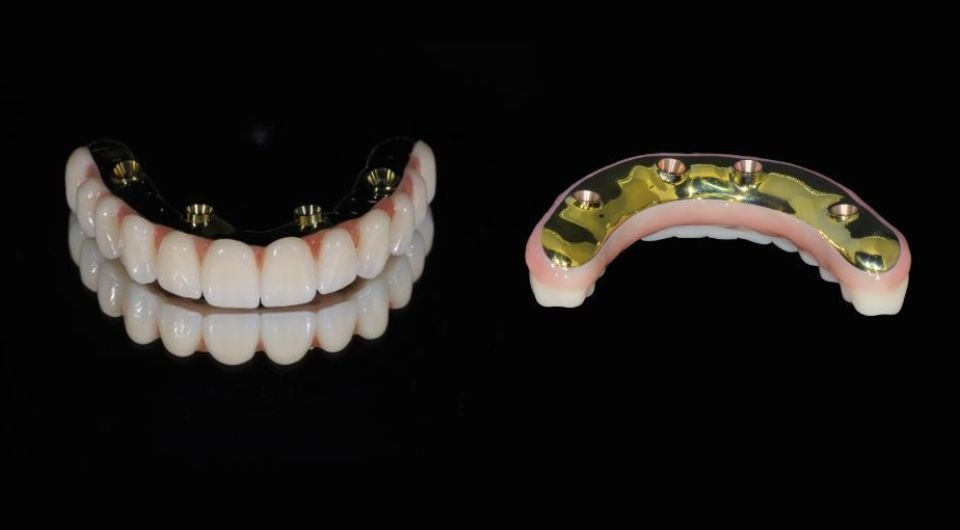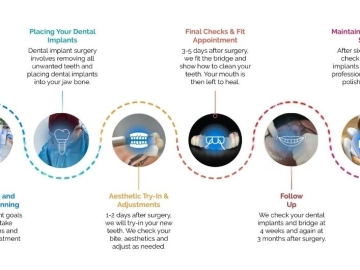
Posted on: 17 October, 2025
Titanium dental implants are designed to last a lifetime with proper care
5 minute read
If you want to replace all of your upper or lower teeth, All-on-4® dental implants are a fixed alternative to dentures that can be long-lasting and easy to maintain. The All-on-4® procedure supports a full bridge of teeth on just four implants, usually fitted within five days of surgery.
When your treatment is provided by an experienced dentist and you follow a good oral hygiene routine and avoid smoking, your new teeth may last for many years or even decades, making All-on-4® implants a long-term investment in your smile. However, poor oral hygiene and lifestyle habits could lead to implant failure.
Read this guide to find out more about how long dental implants and bridges may last and how to avoid dental implant problems. If you want to discuss your suitability for All-on-4® implants or other teeth replacement solutions, schedule a consultation with our dentists in Mount Lawley.
.jpg)
To understand how long All-on-4® implants last, it's important to distinguish between the dental implants themselves and the dental bridge.
While titanium implants very rarely need to be replaced, the prosthetic teeth attached to them will need to be replaced after a number of years. How long depends on what the bridge is made from and how well it’s cared for.
.jpg)
Titanium is a strong and biocompatible material that integrates with the jaw bone to hold implants securely in place. Long-term studies by Nobel Biocare have demonstrated high survival rates for All-on-4® implants of up to 93% after 10-18 years* (implant cumulative survival rate in the lower jaw) and up to 98.8% for the prosthetic teeth (only 4 out of 471 patients lost their bridge due to implant failures).
To find out more about the All-on-4® implants and bridge options we offer at Mount Lawley Dental, call our team today on (08) 9227 8777 to book a consultation.
*Malo P, de Araujo Nobre M, Lopes A, et al. The All-on-4 treatment concept for the rehabilitation of the completely edentulous mandible: A longitudinal study with 10 to 18 years of follow-up. Clin Implant Dent Relat Res 2019;21(4):565-577.
Several factors contribute to the success of All-on-4® treatment and the risk of implant failure, which can affect how long dental implants will last. These include:

The type of implants your dentist uses can affect their durability, with lower-quality implants being more prone to complications.
At Mount Lawley Dental, our dentists use NobelParallel® Conical Connection (CC) dental implants with Xeal™ abutments and TiUltra™ surfaces for All-on-4® treatments. These advanced materials improve attachment to the gums and protect the underlying bone, for more predictable treatments and a higher chance of successful results. Clinical studies by Nobel Biocare of these implants have demonstrated excellent bone response and no complications after three years of follow-up care.*
In terms of dental implant outcomes, Nobel Biocare is the most researched implant system available.
* Ferro, Ana and Miguel De Araújo Nobre. All-on-4® concept using TiUltra surface implants and Multi-unit Xeal abutments: Report on the outcomes between 6 to 36 months. Clin Oral Impl Res;34(S27):137-138.
Placing dental implants involves a series of minor surgical procedures, which must be carried out by a suitably qualified and experienced dentist who has been fully trained in the All-on-4® treatment protocol. Each stage of implant treatment requires careful planning to ensure that every implant is positioned at the optimal angle and location for long-term success. Implants that are incorrectly placed have a higher risk of complications or failure.
The All-on-4® protocol is not taught as part of the standard Bachelor of Dental Surgery (BDS) curriculum. General dentists who wish to perform this procedure must pursue additional postgraduate training, often through short or modular courses that focus on both standard and advanced surgical techniques for placing full-arch dental implants.
Oral health conditions such as gum disease and infections can affect dental implants just as they affect natural teeth. Peri-implantitis or peri-implant disease is the inflammation of the gum around implants, which can happen when bacteria build up in the mouth. If this condition isn’t treated, it can damage the supporting gum and bone tissue and lead to implant failure.
These problems can mostly be prevented with a good oral hygiene routine and keeping up with your regular dental visits and bridge cleans. Neglecting your oral hygiene by not brushing regularly can increase the risk of complications.
Dental implants require a suitable size and density of jawbone for supporting a bridge. The surgical protocol of All-on-4® implants maximises the available jawbone for placing implants, but if you have experienced significant bone loss, you may not be a candidate for All-on-4® or additional insurances by way of longer or additional implants may be recommended by your dentist. If your bone health declines after implants are placed, this can also cause implants to fail.
If you do have a smaller jaw, your dentist might discuss a bone grafting procedure to increase its density using transplanted tissue. However, this involves additional surgery, and it may not be an option for people with certain medical conditions that affect healing.
_2.jpg)
The risk of implant failure increases if you smoke, drink excessive alcohol, or don’t follow a healthy diet. Studies have found that smokers have a 140% higher risk of implant failure compared to non-smokers.* This may be because smoking reduces blood flow to the gums, which can delay the healing process, prevents implants from integrating with the bone, and increases the risk of related problems such as peri-implantitis.
If you grind or clench your teeth (bruxism), this can also put stress on prosthetic teeth and implants, leading to damage or eventually implant failure. Your dentist may discuss strategies for managing these habits or behaviours to lower your risks, such as night splint.
* Mustapha AD, Salame Z, Chrcanovic BR. Smoking and Dental Implants: A Systematic Review and Meta-Analysis. Medicina (Kaunas). 2021 Dec 27;58(1):39. doi: 10.3390/medicina58010039. PMID: 35056347; PMCID: PMC8780868.
The bridge of replacement teeth attached to your All-on-4® implants will be designed to look and feel as close to natural teeth as possible, but some materials are more resilient than others. The type of bridge you choose can directly impact on how long it lasts and the level of care you need to take when eating to avoid damaging or staining your new teeth.
Some dentists may place a temporary acrylic (plastic) bridge as your first set of All-on-4® teeth while your mouth is healing from implant surgery. These are only designed for short-term use and may wear out within 3–6 months for a 100% acrylic bridge or 6–12 months if the bridge is reinforced with cast metal. You should avoid eating hard, crunchy or sticky foods with a temporary bridge.
_1.jpg)
A stronger and longer-lasting alternative to a full acrylic bridge is an acrylic bridge reinforced with a titanium frame. This allows the bridge to last longer, typically 2–5 years with proper care. Once the bridge wears down, you’ll have the option of replacing it or remodelling a new acrylic bridge around the existing titanium frame.
At Mount Lawley Dental, our dentists place a high-impact acrylic bridge reinforced with a digitally-milled titanium frame as your initial All-on-4® bridge. You may choose to replace your bridge with zirconia after your mouth has healed from surgery, or you may choose to keep the one you have.
Acrylic is prone to staining over time, just like natural teeth. Teeth made of zirconia are stain-resistant and long-lasting.
_1.jpg)
If you want a stronger material for a replacement bridge, your dentist may offer a milled zirconia bridge reinforced with titanium. These bridges can last 10–15 years or even longer with a healthy diet, lifestyle and proper oral hygiene routine. A zirconia bridge may also be layered with porcelain for a closer match to natural tooth enamel, balancing aesthetics and strength.
A zirconia bridge isn’t used as the first All-on-4® bridge because it takes longer to make and can’t be easily adjusted while your bite changes during healing.
.jpg)
While the lifespan of your implants and bridge are partly determined by their design, there are ways you can help them to last as long as possible:
If you’re ready to begin your All-on-4® treatment or you want to find out more, get in touch with our dentists at Mount Lawley Dental. Call (08) 9227 8777 to schedule a consultation at a time that’s good for you or book online. We welcome patients from all nearby suburbs, including Highgate and Inglewood.
Any surgical or invasive procedure carries risks. Before proceeding, you should seek a second opinion from an appropriately qualified health practitioner.

From Consult to Smile: The All-on-4® Journey

Overseas All-on-4® Treatment vs Australia: Is It Safe?

All-on-4® Recovery Diet: What to Eat After Surgery